![]()
The Bürger family emigrants and Gnadenthal, Victoria
Peter Bürger, who brought his family to Australia, was born in the village of Meschwitz in the administrative district of Upper Lusatia in the kingdom of Saxony on 1st October 1795. On 3rd May 1831 he married Agnes Schmidt. The Bürgers could speak German, but were members of the Sorbian minority that still live in that area of Germany. In the Sorbian language the family name is spelled Byrgar. In the home the Sorbians/Wends spoke their own language, and spoke German in the church and in the community. Economic conditions for farming people at that time, especially in that part of Germany, were bad, with crop failure causing great hardship. In the late 1840s the political instability in Germany caused by the failed revolutions of 1848 made some people afraid of the possibility of war. Some people could remember Napoleon coming through the region in 1811 on his way to Russia, forcibly taking young men with him.
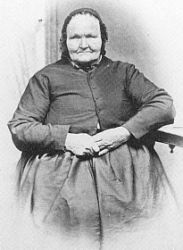 Agnes Bürger |
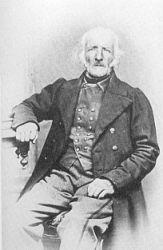 Peter Bürger |
Earlier emigrants had used river and canal barges to get from the eastern German states to the ports of Hamburg, Bremen, or Bremerhaven, but Peter Bürger and his family were able to use the recently built railways. Their ship the Helene, on its maiden voyage, finally passed Cuxhaven and entered the open sea on 4th September 1851. With Peter and Agnes were their teenage children Johann, Magdalene and Andreas, and they reached Port Adelaide on Christmas Eve 1851. Of the 128 emigrants on the Helene, 98 were Sorbs/Wends, including the Mirtschin family, who also settled later at Gnadenthal. Peter Bürger was 56 when he arrived, and soon became naturalised, allowing him to buy land at Rosenthal, South Australia, now known as Rosedale. As not much land was available for buying, Peter and others decided to go to the south-west of Victoria, which some Germans had reported favourably on. He sold his land, bought a waggon, and the group of 11 waggons (some drawn by horses, some by bullocks) left on 4th April 1852. The difficult journey to Portland over rough tracks and across rivers took over 6 weeks. They prayed together every day of the trip.
For a while they were disappointed in not being able to get land they thought was for sale, but eventually they bought land near Mt Rouse. They named their settlement Gnadenthal and set aside some land for a cemetery. They often took their farm products by waggon to the goldfields at Ballarat, where prices were higher.
Two cottages built by the Bürgers in 1853 when they settled in Gnadenthal still stand today. They are made from split timber, with the spaces between the timber pieces filled with pug (a mixture of mud and grass). These two buildings are historically important, because parts of the walls and ceilings also include a building method called Lehmwickel; such examples are rare. This "earth winding" method has been found in German settlements in Hungary, North America and Australia. In The Lost Art of Earth Winding, Miles Lewis described the method:
Lehmwickel is used in the ceiling of the Bürger cottage, and the internal partitions of the stable. It seems that straw has been laid out flat with the stalks parallel, and a mud slurry poured on to it, or else that the straw has been combed through a container full of slurry, and (in either case) the layer of muddy straw has been rolled up onto the wooden stake like a roller blind. The stakes are of roughly split timber about a metre long, 20 to 30 mm thick and 60 to 80 mm wide, with pointed ends which protrude from the end of the mud cylinder, the overall diameter of which is about 100 mm. The cylinders were then placed horizontally between the ceiling joists, or vertically in a row in the panels of the timber frame, with the pointed ends resting in holes prepared for them. As they were put in place while the mud was still soft, they fitted together snugly. In the case of the ceiling there seems to have been a calico lining below them, suggesting that their function was simply that of insulation.
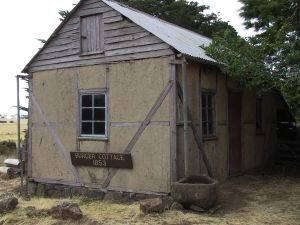 Bürger-Haus, 1853 |
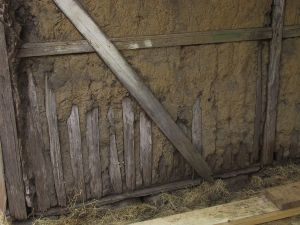 Lehmwickel-Wand |
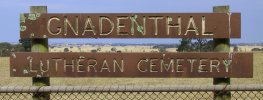
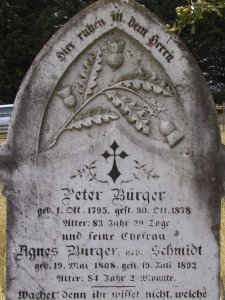 Gravestone of Peter and Agnes Bürger, in Gnadenthal cemetery |
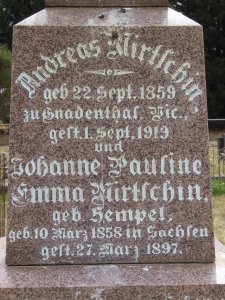 Gravestone of Andreas and Johanne Mirtschin, in Gnadenthal cemetery - Andreas was the son of the second settler in Gnadenthal. |
| Top | Back
| Chronology | Issues
| Students | Site Map |
auf Deutsch |
| Primary Sources (in German) | Bibliography
| Search |
German Australia © D. Nutting 2001